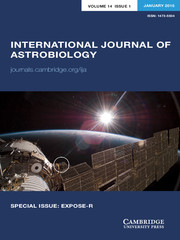Article contents
The biotic effects of large bolide impacts: size versus time and place
Published online by Cambridge University Press: 01 October 2008
Abstract
In estimating the biotic effects of large terrestrial impacts we are reliant upon apparent crater diameter as a proxy for impact magnitude. This underlies the ‘kill-curve’ approach which graphs crater diameter directly against likely percentage losses of taxa. However, crater diameter is a complex product of syn- and post-impact processes that can be site-dependent. Furthermore, location (global positioning) and timing (moment in geological history) also strongly influence biotic effects. We examine four of our largest and best-documented Phanerozoic impacts to explore this more holistic size–time–place relationship. Only the c. 180 km end-Cretaceous Chicxulub crater (Mexico) links to any substantial immediate extinction and some of the worst effects stem from where it struck the planet (a continental margin carbonate platform site) and when (a time of high regional and global biodiversity). Both the c. 100 km late Triassic Manicouagan crater in NE Canada (arid continental interior, low regional and world biodiversity) and the c. 35 Ma 100 km Popigai crater, Siberia (continental arctic desert) provide much less damaging scenarios. However the c. 90 km Chesapeake Bay crater, Eastern USA (also c. 35 Ma) marks a far more sensitive (Chicxulub-like) site but it also proved relatively benign. Here the rheologically varied shallow marine target site produced an anomalously broad crater, and the scale of the impact has evidently been overestimated. We offer a new approach to the graphical prediction of biotic risk in which both crater diameter and a generalised time/place factor we term ‘vulnerability’ are variables.
Information
- Type
- Research Article
- Information
- Copyright
- Copyright © 2008 Cambridge University Press
References
- 15
- Cited by

